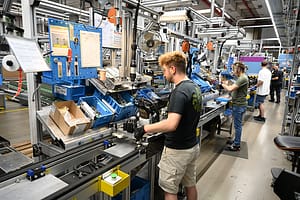As UK businesses forge ahead with digital transformation strategies, the network demands of tomorrow are rapidly coming into focus. Beyond the day-to-day realities of file sharing and email, organisations are adopting data-heavy applications—artificial intelligence (AI), Internet of Things (IoT) sensors, and real-time analytics—that push connectivity requirements to new heights. With 5G and Wi-Fi 6 rolling out at pace, data cabling in offices, warehouses, and other commercial settings must evolve to keep up. This article explores how these emerging technologies will shape data cabling choices and offers practical insights for future-proofing your infrastructure. (Data compiled by ACCL, who are leading wi-fi Installation experts in London)
1. 5G and Wi-Fi 6: More than just buzzwords
What 5G Brings to the Table
5G is typically perceived as a mobile technology, but its implications for business networks are profound. Offering considerably higher speeds and lower latency compared to 4G, 5G can support mission-critical applications like remote robotic surgery or autonomous vehicles—though more relevant to most organisations is its potential in massive machine-type communications (mMTC). Think large-scale IoT deployments in manufacturing or logistics that generate huge data volumes. While 5G will lessen the dependency on wired connections in some scenarios, the backhaul behind cellular base stations and repeaters still relies on robust cabling.
Why Wi-Fi 6 Matters
Wi-Fi 6 (802.11ax) delivers faster speeds and better support for high-density environments—ideal for businesses with open-plan offices or numerous connected devices (e.g., phones, laptops, printers, sensors). Its efficiency gains extend to IoT devices, enabling them to consume less power during data transmission. However, Wi-Fi 6 access points often require multi-gigabit uplinks (2.5 Gbps or 5 Gbps), which means the underlying cabled network must be ready to accommodate these faster connections.
2. The growing importance of backbone infrastructure
Fibre Optics for High-Capacity Backbones
As endpoints clamour for higher speeds, the central (or “backbone”) infrastructure of a network becomes critical. Connecting floors or entire buildings via fibre optics is increasingly common, thanks to fibre’s high bandwidth, reliability, and long reach. With single-mode or multi-mode fibre providing 10 Gbps or higher performance, backbones can easily funnel data between Wi-Fi 6 access points, servers, or edge devices without creating bottlenecks.
Multi-Gigabit Copper Links
While fibre is the standard for backbone links, certain environments still benefit from copper cables—especially in existing buildings where running new fibre may be cost-prohibitive. Technologies like NBASE-T allow for 2.5 or 5 Gbps speeds over Category 5e or Category 6 cabling, potentially extending the usable life of older cables. For newer builds, however, investing in Category 6A or 7 ensures headroom for future multi-gigabit wireless backhauls.
3. How IoT is reshaping cable strategies
Expanding the Network Edge
The Internet of Things extends your network beyond traditional desktop PCs and printers. Sensors, cameras, and other smart devices can appear in unexpected places—under desks, on ceilings, or even outdoors—to collect real-time data. This expansion of the “network edge” pushes cabling into areas not previously served by wired connections.
Power over Ethernet (PoE) Opportunities
One of the key enablers for IoT is PoE. Delivering power and data over a single cable eliminates the need for separate power sockets, reducing both clutter and installation costs. As IoT adoption grows, UK businesses are increasingly installing higher-powered PoE (up to 90W via 802.3bt) to support more demanding devices like digital signage or even some industrial machinery controllers.
4. Designing for flexibility and scalability
Modular Patch Panels and Racks
Given the dizzying rate at which networking standards evolve, a rigid cabling setup can quickly become obsolete. Modular patch panels and racks allow for easy reconfiguration, letting you swap connections or add new ports without a complete redesign. This approach also saves time if you need to upgrade to higher-category cables in targeted areas.
Zoned Cabling for Larger Spaces
Warehouses, factories, and large open-plan offices are prime candidates for zoned cabling. Instead of running individual cables all the way back to a central cabinet, you set up intermediate distribution points (IDFs). Each zone has its own patch panel feeding local devices—ideal for IoT expansion, where new sensors may be added regularly.
5. Sustainability and regulations
Low Smoke Zero Halogen (LSZH) Cables
UK building regulations increasingly emphasise fire safety and environmental standards, making LSZH cables a common requirement in offices, schools, and public buildings. These cables emit minimal toxic fumes in the event of a fire, reducing risks to occupants and aiding in compliance checks.
Green Data Centres and Reduced Footprint
As data-intensive technologies proliferate, the spotlight on energy consumption grows brighter. Some businesses aim to cut their carbon footprint by using eco-friendly practices—such as structured cabling that minimises run lengths or advanced cable management that keeps cooling loads down. Though sustainability might not be a direct driver of cable selection, it’s an important aspect of holistic network design, especially as regulatory pressure mounts.
6. Planning for future wireless standards
Beyond Wi-Fi 6: Wi-Fi 7 and 6G
Technology never stands still. The success of Wi-Fi 6 sets the stage for Wi-Fi 7, which promises even higher throughput and improved multi-link operation. On the mobile side, early discussions around “6G” are already underway, likely delivering speeds that will once again require robust cable-based backhaul. Planning your cabling infrastructure with an eye towards these next standards can protect your network from short-lived obsolescence.
Upgrading in Phases
Staying current doesn’t mean you have to rip and replace everything at once. Many UK businesses find success in phased upgrades—updating core backbone links to multi-gigabit or fibre first, then refreshing edge switches and access points as budgets permit. The goal is to maintain a coherent, high-performing whole even during transitions between standards.
7. Best practices for a future-ready installation
- Conduct a Thorough Needs Assessment: Estimate not only your current bandwidth requirements but also the potential impact of new wireless technologies, IoT devices, and growth in data traffic.
- Label and Document: Whether you’re deploying fibre or higher-category copper, a well-labelled and clearly mapped network reduces downtime and aids troubleshooting.
- Emphasise Testing and Certification: All new or upgraded cable runs should be tested with professional equipment (e.g., Fluke) to confirm bandwidth capacity and signal integrity.
- Incorporate PoE Where Possible: With the surging popularity of IoT and remote work, PoE can save significant costs on electrical installation, provided you account for heat dissipation in switches.
- Stay Informed on Regulatory Changes: Fire safety, health and safety mandates, and environmental guidelines can influence material selection and installation methods in the UK.
Where expert guidance fits in
Upgrading data cabling in line with 5G and Wi-Fi 6 isn’t always straightforward. Each environment—be it an industrial site or a high-rise office—presents unique challenges. Consulting specialists ensures your project adheres to regulations, meets performance goals, and remains scalable. Firms like ACCL, for instance, can conduct site surveys, help design modular and future-proof networks, and carry out certified installations across London, Kent, Surrey, and neighbouring areas. Engaging professionals early in the planning process often results in more accurate budgets and smoother rollouts.
Bottom line
5G, Wi-Fi 6, and the proliferation of IoT devices are transforming how UK businesses connect, analyse, and exchange data. In the midst of these changes, data cabling emerges as a critical foundation—one that must scale to accommodate higher speeds, extra power requirements, and evolving wireless standards. By choosing the right mix of copper and fibre, adopting structured cabling techniques, and planning for future technologies, organisations can set themselves up for long-term success. The network demands of tomorrow may be complex, but with careful strategy and expert implementation, your cabling infrastructure can become a powerful enabler of innovation and growth.






Leave a Comment